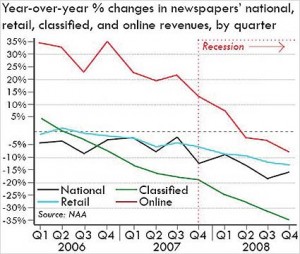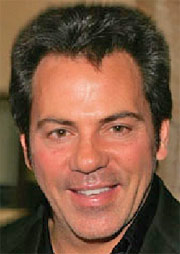Asserting that the collapse of mainstream media demands the same urgency as “the threat of terrorism, pandemic, financial collapse or climate change,” two authors of a forthcoming book called Saving Journalism propose massive government intervention in the journalism crisis. Writing in the liberal journal The Nation, John Nichols and Robert McChesney say the recent debates over micro-payments and nonprofit funding is all well-intentioned, but these rescue scenarios don’t address the serious structural problems the US media faces. In essence, the public watchdog function is vanishing with nothing to replace it.
This trend isn’t new; cost-cutting in the newsroom began in the 1970s when media tycoons began to form quasi-monopolies under the umbrella of government protection. Today, the media is a pathetic shadow of its former self, doing “almost no investigation into where the trillions of public dollars being spent by the Federal Reserve and Treasury are going but spar[ing] not a moment to update us on the ‘Octomom,'” the authors write.
Government already subsidizes media to the tune of tens of billions of dollars annually through mailing discounts, government advertising, monopoly broadcast, cable and satellite licenses and copyright protection. However, private interests have taken advantage of those subsidies to create wealth, and in the process are destroying the services they provide the public, Nichols and McChesney assert.
And they get specific about what needs to be done:
- Eliminate postage for periodicals that get less than 20% of their revenues from advertising;
- Give all Americans an annual tax credit for the first $200 they spend on daily newspapers or online sources that meet certain quality criteria;
- Allocate funds to enable every middle school, high school and college to have a well-funded student newspaper, a low-power FM radio station and accompanying substantial websites.
Face it: The old system is collapsing and won’t be resurrected, they say. We are entering a world in which government abuse and corporate greed will run rampant because no one is watching over the abusers. The business media completely misled the public about what was happening in Iraq and completely missed signs of financial disaster. And that was before 20,000 more journalists lost their jobs.
Although you need to take the left-wing source into account, this article is a pretty compelling argument for government intervention. It is particularly chilling in its description of the impact that media cutbacks have already had on the public’s ability to understand the financial crisis and its own legislators’ actions. The authors maintain that the estimated $20 billion cost of their proposal is a drop in the bucket compared to the amount being spent on the financial bailout. The stretch may be in equating the urgency of the two problems.
Uphill Climb

Stewart: Millennials' Cronkite?
The Nation will have a battle convincing a skeptical American public that government support is the answer. Recent data from Rasmussen Reports paints a picture of a public that is largely disengaged from traditional media institutions while increasingly deriving its news from entertainment. A telephone survey of 1,000 Americans early this month found that 30% overall read a daily newspaper, but among respondents under 40, that percentage was only half as large. The survey also showed that newspaper websites have less “stickiness” than a product that arrives at the front door each day. Only 8% of US adults say they read their local paper’s website every day.
Meanwhile, one-third of Americans under 40 say Comedy Central’s Daily Show and Colbert Report are replacing traditional news outlets, which is slightly more than the 24% of Americans overall who think this is true. And there’s a popular opinion that this is a good thing. “Thirty-nine percent of adults say programs of this nature are making Americans more informed about news events, while 21% believe they make people less informed,” the report says. Interestingly, Democrats are much more inclined to share this positive view than Republicans, by a margin of 48% to 28%.
Miscellany
The New York Times Co. imposed temporary 5% pay cuts for most employees in hopes of avoiding cuts to the newsroom staff. Nevertheless, the Times also laid off 100 people in its business operations and said it would reduce freelancer spending and possibly consolidate some sections. The pay cuts are subject to union agreement. Times management threatened to lay off 60 to 70 people out of its 1,300-person news staff if the union doesn’t concur. The Times Co. cited an overall drop in advertising revenue of 13.1% in 2008 and 17.6% in the fourth quarter. The pay reductions were described as temporary. Salaries will revert to their previous level next year unless economic conditions improve fail to improve. The company has already laid off more than 500 people this year.
The recession has clearly taken hold in the advertising business and the result is likely to be “the closing of more big regional daily newspapers and bankruptcy declarations from even more big publishers,” according to Media Post. Fourth-quarter 2008 results were a disaster, and that’s coming on top of two years of declines that seemed to get worse with each quarter. Newspaper classified advertising fell 39.2% overall in the quarter, with job-recruitment advertising plunging nearly 52%. Perhaps more ominous is that online revenue at newspaper sites was off 8% in the quarter, although online advertising is weak across the board right now.
The Rockingham News of southern New Hampshire has just published its final edition, and the weekly that has served the region for more than 40 years offers quite a lesson in its own history. Aubrey Bracco must have interviewed a couple of dozen local residents to get their recollections of what the paper meant to them, and he pens a loving and informative farewell.
Mike Hughes, president and creative director at the Martin Agency, pens an impassioned plea to his colleagues to support newspapers with their advertising dollars. “Our industry needs newspapers — but just as important, so does humankind,” he writes. So stop following the latest trend and putting your advertising in the trendiest places. “How many agencies aren’t selling newspaper advertising to their clients as hard as they should? It’s time for a wake-up call.” It’s an invigorating argument until you read the bio and see that Hughes’ employer is the “agency of record for the Newspaper Association of America.”
Writing on Mashable, Woody Lewis lists five ways newspapers can embrace social media more effectively. He notes that The New York Times now has an application programming interface that third parties can use to access its content from their programs. This is a cool idea. He also says partnerships with strong technology partners are a good idea.
Jay Rosen lists a dozen articles about journalism that he really thinks you should read, although we can’t fathom his top pick: Paul Starr’s laborious New Republic epic. Many of the others are excellent, though, and a few we hadn’t seen before.
And Finally…
We were thrilled to be included among the “Death of Newspapers” bloggers cited by Paul Dailing in Huffington Post. We agree with him that our self-absorbed, righteously indignant, told-you-so attitude is crap and that we have no answers to the problems facing the industry. We encourage you to boycott our book (available in fine bookstores everywhere) in support of his position. We should be ashamed of ourselves.

 The Houston Chronicle joins the long string of newspapers that assert their commitment to “strong watchdog journalism” while covering news of their own troubles with e.e. cummings-like simplicity. The newspaper devotes just 208 words to news that it is laying off 12% of its staff, or nearly 200 people. That’s about one word per victim. In fact, the Chronicle doesn’t even mention a body count. You have to
The Houston Chronicle joins the long string of newspapers that assert their commitment to “strong watchdog journalism” while covering news of their own troubles with e.e. cummings-like simplicity. The newspaper devotes just 208 words to news that it is laying off 12% of its staff, or nearly 200 people. That’s about one word per victim. In fact, the Chronicle doesn’t even mention a body count. You have to 






 Today is Newspaper Death Watch’s second birthday (you can
Today is Newspaper Death Watch’s second birthday (you can 

